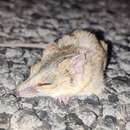ar
الأسماء في صفحات التنقل


Perception Channels: tactile ; chemical
CITES: no special status
IUCN Red List of Threatened Species: least concern
Dunnarts are insectivorous. They have also been known to eat small vertebrates like lizards and mice. Their prey is caught on the ground. S. macroura may store fat in its tail during periods of abundant food and can then use those fat stores when food is scarce (Nowak 1983).
Sminthopsis macroura, the narrow-footed marsupial "mouse", or the striped face dunnart, is found from central Western Australia to western Queensland and northern New South Wales (Nowak 1983)
Biogeographic Regions: australian (Native )
Narrow-footed marsupial "mice" are found in dry areas (Nowak 1983).
Terrestrial Biomes: desert or dune ; savanna or grassland
Average lifespan
Status: captivity: 4.9 years.
Weight is sexually dimorphic in this species with females weighing on average 16 grams and males weighing on average 19 grams. Head and body length ranges from 70 to 120 mm, and tail length is approximately 55 to 130 mm. Coloration is buffy to grayish on the back and sides with white underparts. The feet are also usually white and the tail is either brownish or grayish. The genus Sminthopsis can be differentiated from other marsupial mice by skull and dentition features. Their feet are slender and they have a black stripe down the face - giving them their common name. The pads on the feet are striated and the hind part of the soles lack pads. Narrow-footed marsupial mice have a relatively well developed pouch for a dasyurid. One other striking physical feature is the tail; during times of abundant food, it will accumulate fat and become carrot shaped. (Nowak 1983, Lovegrove 1999)
Other Physical Features: endothermic ; bilateral symmetry
Average mass: 20.6 g.
Average basal metabolic rate: 0.128 W.
In a captive colony of S. macroura , the breeding season was found to last from June to February. These animals have an iteroparous life-history strategy. The following information was also obtained from captive colonies; it is not known from wild S. macroura. Females are polyestrous with one cycle lasting approximately 26.2 days. Ovulation occurs spontaneously. Time of gestation is 12.5 days and after birth the young are carried in the pouch for 40 days. Litter size can range from 1 to 8 young. Female striped face dunnarts have 8 mammae. If a female has only 1 or 2 young she may not rear them. After the young leave the pouch, they are suckled in the nest for another 30 days. Sexual maturity in females depended on when they were born. Those born early in the season matured at 86-159 days, while those born later in the same season matured at an earlier age. Individual male dunnarts are capable of breeding over long periods during the breeding season. Males do not appear to be sexually mature until the season after their birth. It has been found that the timing of mating and litter production corresponds to the period of maximum sperm production. Male S. macroura show a relatively low amount of sperm production when compared to other Dasyurid species. (Nowak 1983, Taggart 1997, Woolley 1990a, Woolley 1990b)
Key Reproductive Features: gonochoric/gonochoristic/dioecious (sexes separate); sexual
Average birth mass: 0.01 g.
Average gestation period: 12 days.
Average number of offspring: 4.
Average age at sexual or reproductive maturity (male)
Sex: male: 159 days.
Average age at sexual or reproductive maturity (female)
Sex: female: 119 days.